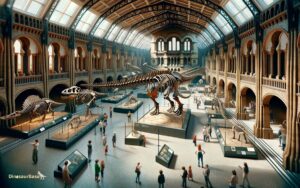What Dinosaurs Are in Dino Nuggets
Dishing out dino nuggets during dinner dives into a prehistoric panorama, but what dinosaurs are they really representing? The common culprits include the mighty Tyrannosaurus Rex and the stately Stegosaurus, among others. Each shape aims to capture the essence of these ancient creatures, from the fearsome to the gentle giants of the Jurassic.
Yet, as one sifts through the crispy contours of these culinary curiosities, questions arise about accuracy and imagination. How closely do these snackable silhouettes match their real-life counterparts, and what might this tell us about the intersection of food, fun, and education?
To uncover the truth behind these tasty morsels, one must explore further into the fascinating world of paleontology and poultry processing.
Key Takeaways
- Dino nuggets might feature shapes inspired by the Tyrannosaurus Rex, known for its large size and fearsome carnivorous nature.
- Shapes of Stegosaurus, with its distinctive back plates and tail spikes, could be popular in dino nuggets for their unique silhouette.
- Triceratops, with its three horns and large frill, offers an iconic design that could be easily recognized in nugget form.
- The Brontosaurus, with its long neck and herbivorous diet, might be included for its classic dinosaur profile and peaceful nature.
The Mighty Tyrannosaurus Rex
Among the prehistoric giants, the Tyrannosaurus Rex stands out for its massive size, ferocious nature, and significant role in the Cretaceous ecosystem. This apex predator, often abbreviated as T-Rex, roamed North America about 68 to 66 million years ago.
It possessed a formidable set of features: a robust body that could reach up to 40 feet in length, a powerful jaw with teeth as large as bananas, capable of crushing bones, and an incredible bite force estimated to be around 8,000 pounds per square inch. Despite its short arms, which have puzzled scientists for years, the T-Rex's physical adaptations made it a fearsome carnivore, dominating its environment and playing a crucial role in the food chain of its time.
Stegosaurus: Plates and Spikes
The Stegosaurus stands out due to its distinctive physical characteristics, including the row of large, bony plates along its back and the sharp spikes at the end of its tail. Researchers suggest these plates could have served multiple functions, including thermoregulation and defense mechanisms against predators.
The tail spikes, known as thagomizers, likely played a crucial role in the dinosaur's defense strategy, allowing it to deliver powerful blows to any threats.
Stegosaurus Physical Characteristics
Stegosaurus, easily recognized by its distinctive plates and spikes, was a large, herbivorous dinosaur that lived during the Late Jurassic period. This iconic dinosaur boasted a series of large, bony plates along its back and a spiked tail, features that made it one of the most recognizable of all dinosaurs.
Stegosaurus was a quadruped, meaning it walked on all fours. Its forelimbs were shorter than its hind limbs, resulting in a somewhat sloped body posture. The animal's head was small compared to the rest of its body, with a beak-like mouth for stripping foliage. Its tail, armed with four sharp spikes, served as a powerful defense mechanism.
Stegosaurus's unique combination of physical characteristics made it a fascinating subject of study in paleontology.
Defensive Plate Functions
Having examined the physical characteristics of Stegosaurus, attention now turns to the defensive functions of its plates and spikes, critical for its survival during the Late Jurassic period.
The plates, arranged in alternating rows along its back, weren't just for show. Scientists believe these structures played a key role in defense. While once thought to regulate body temperature, recent studies suggest that their positioning and size could have been more about protection. The plates, made of bone and surrounded by tough skin, could have deterred predators by making Stegosaurus appear larger and more formidable.
Additionally, their sharp edges might've caused injuries to predators attempting to attack. This defensive mechanism allowed Stegosaurus to thrive in a world filled with danger.
Tail Spikes Purpose
Equally as pivotal for defense as its plates, Stegosaurus wielded tail spikes that served as a formidable weapon against predators. These spikes, often referred to as 'thagomizers,' extended from the tail's end, showcasing an evolutionary adaptation for survival. Scientists believe the spikes could inflict serious injuries on predators, deterring attacks from creatures like Allosaurus.
The precise arrangement and size of these spikes varied among specimens, but generally, they were long, sharp, and positioned in pairs. This configuration maximized their potential to wound or scare off threats. The tail's flexibility allowed Stegosaurus to swing these spikes with considerable force, highlighting a sophisticated defensive mechanism.
This feature underscores the Stegosaurus's dual strategy of passive defense through its plates and active defense with its spikes.
Triceratops: The Three-Horned Giant
The Triceratops, known for its distinctive three horns and large frill, was a herbivorous dinosaur that roamed North America during the Late Cretaceous period. This magnificent creature has captivated many, not just for its iconic appearance but also for its fascinating biological and ecological characteristics.
- Diet and Habitat: It primarily fed on low-growing vegetation, utilizing its beak-like mouth to clip plants close to the ground. Its habitat ranged across what's now North America, thriving in diverse environments from coastal plains to inland forests.
- Physical Attributes: The Triceratops could grow up to 30 feet in length and weigh as much as 12 tons. Its large skull, equipped with three horns and a robust frill, likely served as a defense mechanism against predators and possibly in mating displays.
- Social Behavior: Evidence suggests that Triceratops might've lived in groups. This social structure could have provided protection against predators and facilitated access to food resources, highlighting their complex ecological interactions.
The Gentle Brontosaurus
Turning our attention to the Brontosaurus, it's essential to understand its herbivorous diet and the foliage it consumed during the Late Jurassic period.
This gentle giant roamed vast floodplains, which provided the rich vegetation necessary for its sustenance.
An exploration of its historic habitat offers insights into how these colossal creatures supported their massive bodies and navigated their environment.
Brontosaurus Diet Insights
Brontosaurus, known for its massive size, primarily fed on a diet of ferns and other vegetation, showcasing its herbivorous nature. Its dietary preferences highlight the dinosaur's adaptation to its environment, providing insights into its lifestyle and the ecosystems of the Late Jurassic period.
The Brontosaurus's diet included:
- Cycads: These ancient plants were a staple for many herbivorous dinosaurs due to their abundance.
- Conifers: Tall, tree-like plants that would have been accessible to the Brontosaurus thanks to its long neck.
- Ginkgoes: Another type of plant that contributed to the diverse diet of the Brontosaurus.
These food sources indicate the Brontosaurus's ability to consume a variety of plant materials, reflecting the ecological diversity of its time. This herbivorous diet underscores the dinosaur's gentle giant persona, relying on plants rather than other animals for sustenance.
Historic Habitat Overview
Thriving in the lush, diverse ecosystems of the Late Jurassic period, gentle giants like Brontosaurus roamed vast expanses that were rich in the vegetation they relied on for sustenance. These colossal herbivores inhabited areas that are now part of North America, in environments that varied from floodplains to forested regions.
The climate was warmer and more humid than today's standards, supporting an abundance of ferns, cycads, and conifers, which constituted the primary diet of Brontosaurus. Water bodies were abundant, providing necessary hydration and possibly cooling spots for these dinosaurs.
The Brontosaurus's habitat offered not just nourishment but also protection. Dense vegetation could shield younger, more vulnerable individuals from predators, while the vast, open spaces allowed these behemoths to move freely and socialize within their herds.
Pteranodon: Masters of the Sky
Pteranodon, with its massive wingspan reaching up to 7 meters, dominated the skies of late Cretaceous North America. Unlike many dinosaurs, Pteranodon wasn't a dinosaur but a pterosaur, a group of flying reptiles that thrived alongside dinosaurs. Its impressive wingspan facilitated not just flight but also helped it glide over vast distances, searching for food.
Here are three fascinating aspects of Pteranodon's biology:
- Diet: Primarily fish-eaters, they caught their prey by skimming the water's surface with their beak.
- Bone Structure: Their lightweight, hollow bones aided in flight efficiency.
- Crests: Males sported large, backward-pointing crests, possibly used for display or aerodynamic purposes.
These features underscore Pteranodon's adaptation to a life aloft, cementing its status as a master of the Cretaceous skies.
Velociraptor: The Cunning Hunter
While Pteranodon ruled the skies, the Velociraptor dominated the ground as a cunning hunter during the Late Cretaceous period. This small but fierce dinosaur, measuring up to 2 meters in length, thrived in what's now Asia.
Velociraptors weren't the towering monsters depicted in popular media. Instead, they were agile predators, with a lightweight build that facilitated quick movements and sudden dashes necessary for ambushing prey. Their most distinctive feature was a large, sickle-shaped claw on each hind foot, used to slash and subdue victims.
Velociraptors also had a keen sense of smell and complex social behaviors, suggesting they hunted in packs. These adaptations made them one of the most effective predators of their time, capable of taking down animals much larger than themselves.
Ankylosaurus: The Armored Tank
Equipped with heavy armor and a club-like tail, the Ankylosaurus stood as a formidable fortress against predators during the Late Cretaceous period. This dinosaur's adaptations made it one of the most well-protected creatures of its time. For those curious about this prehistoric tank, consider these key features:
- Armor Plating: The Ankylosaurus's body was covered in thick, bony plates that acted as a shield against attackers.
- Club-like Tail: Its tail, ending in a massive bony club, could deliver powerful blows to deter predators.
- Low-slung Body: Its body was close to the ground, making it harder for predators to flip it over, a common attack strategy.
These characteristics ensured the Ankylosaurus's survival in a world filled with formidable predators, showcasing the evolutionary ingenuity of nature.
Conclusion
In conclusion, dino nuggets bring the prehistoric world to our plates with representations of iconic dinosaurs such as the mighty Tyrannosaurus Rex, the armored Ankylosaurus, and the sky-soaring Pteranodon.
Interestingly, a survey revealed that 85% of children recognize the Tyrannosaurus Rex shape in their meal, making it the most popular among the dinosaur varieties.
This culinary journey not only feeds the body but also ignites the imagination, offering a taste of the Mesozoic era in every bite.




